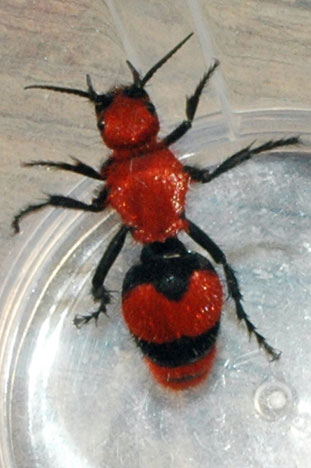Red velvet ant or "cow killer"
Scientific Name: Dasymutilla occidentalis (Linnaeus)
Order: Hymenoptera

 Description
Description: These insects are wasps, not ants. Females are wingless and covered with dense hair, superficially resembling ants. The red velvet-ant is the largest velvet-ant species, reaching about 3/4 inch in length. They are black overall with patches of dense orange-red hair on the thorax and abdomen. Males are similar but have wings and can not sting.
Several other species of velvet ants are common in Texas, including the gray velvet ant or thistle down mutillid, Dasymutilla beutenmulleri, and D. fulvohirta. Most are solitary parasites of immature wasps (Vespidae and Sphecidae), solitary bees and some other insects such as beetles and flies. Winged males can be confused with other Hymenoptera. Adults of the tiphiid wasp, Myzinum sp. (Hymenoptera: Tiphiidae) are black and yellow, 3/4 inch long . They can occur in large numbers, sometimes on flowers of landscape plants. Larvae are parasites of white grubs (Coleoptera: Scarabeidae).
Life Cycle: Females seek the immature stages of ground-nesting bees, digging to the nesting chambers and eating a hole through the cocoon. She deposits and egg on the host larva, which soon hatches into a white legless grub. The immature velvet-ant eats the host larva, developing through several larval stages before forming a pupa.
Habitat, Food Source(s), Damage: Mouthparts are for chewing. Lone females can be found crawling on the ground, particularly in open sandy areas. Adults are most common during the warm summer months. Larvae are solitary, external parasites of developing bumble bees.
Pest Status: The common name, "cow killer," is thought to describe the painful sting these insects can inflict to man and animals, although it is doubtful that many cows are actually stung.

 Author
Topic: Amazing nature (Read 69462 times)
Author
Topic: Amazing nature (Read 69462 times)
